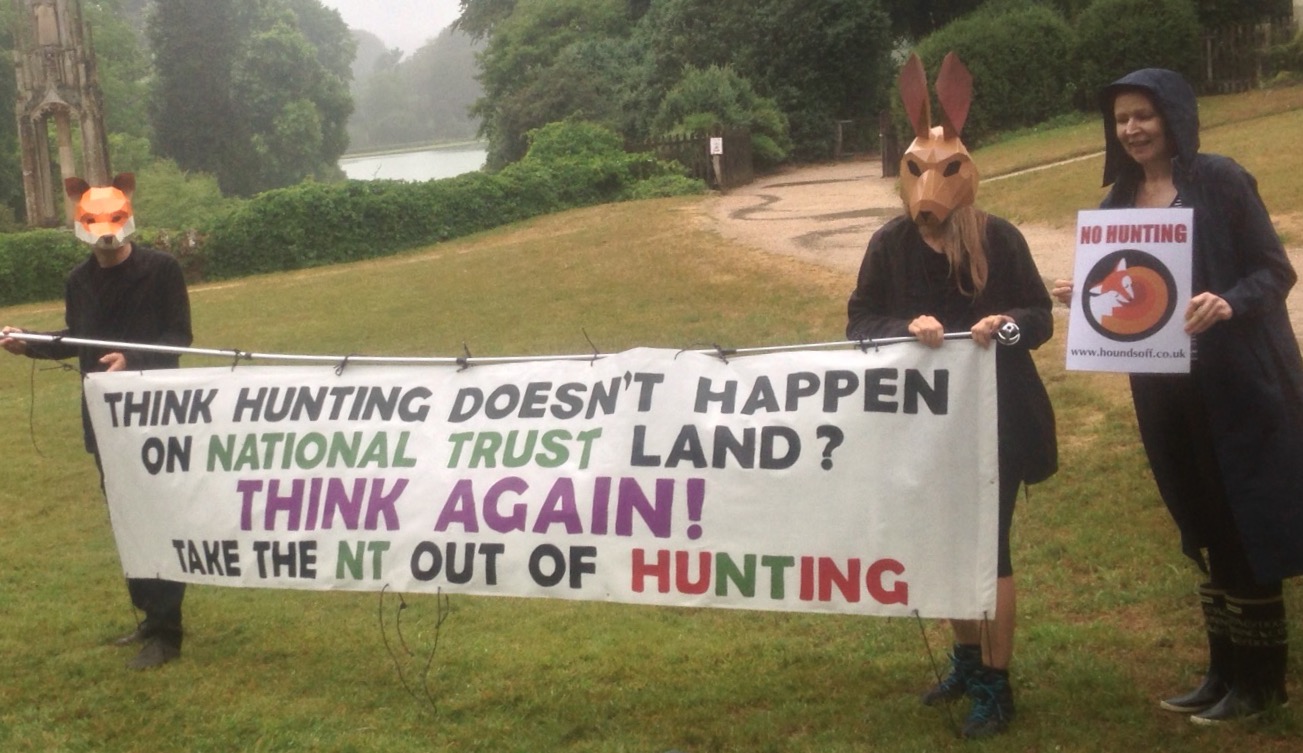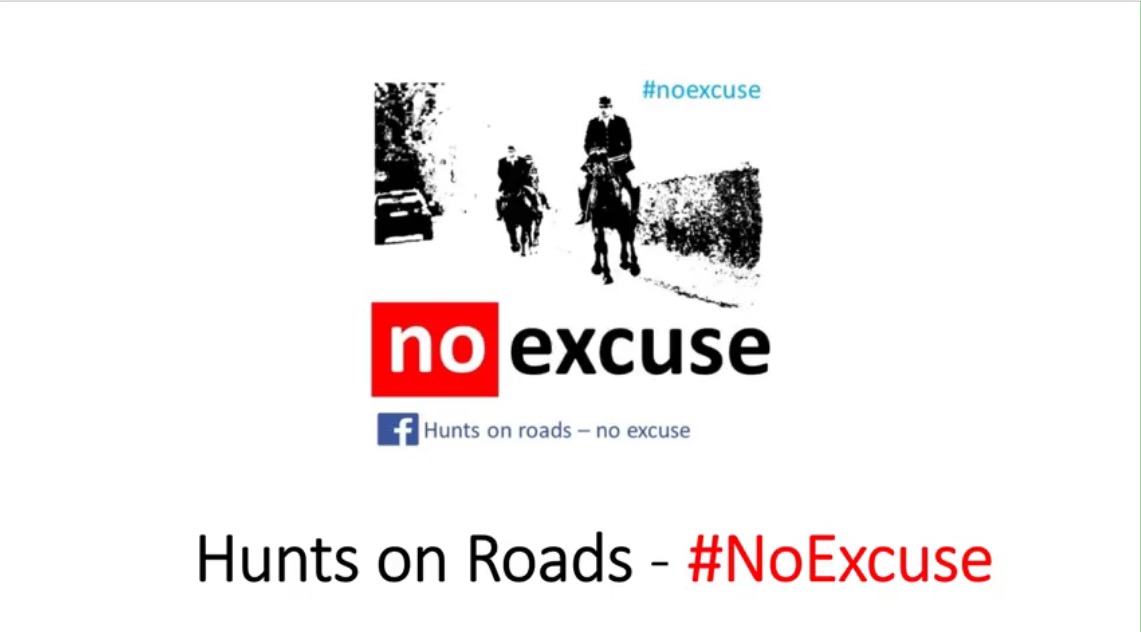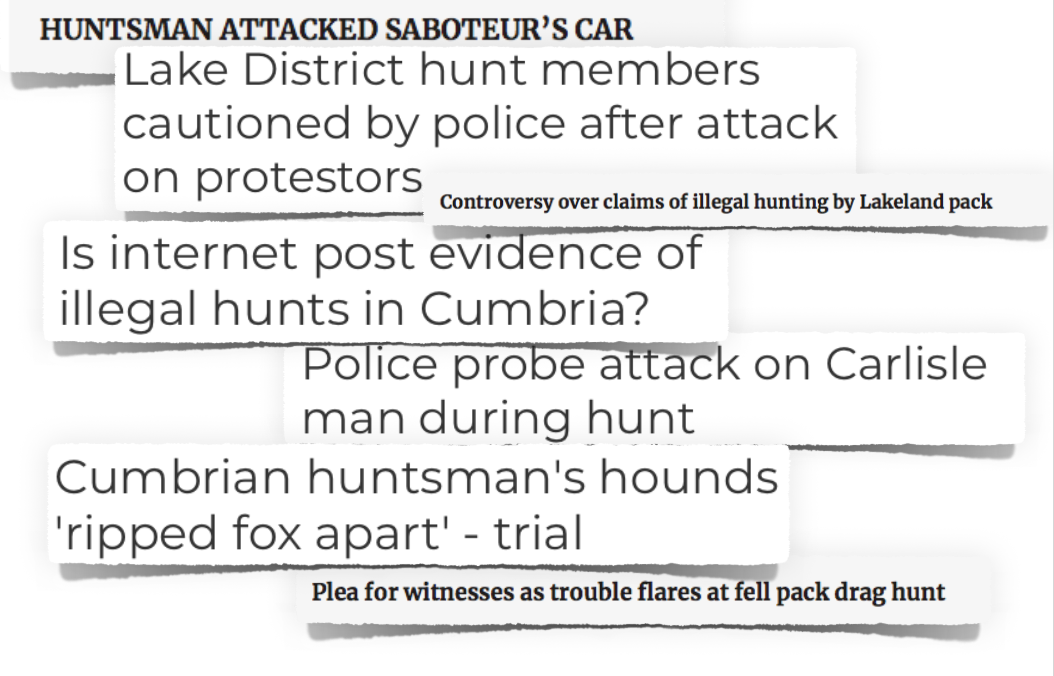25th February 2019
Lactating Fox Hunted In Somerset Churchyard 23.02.19
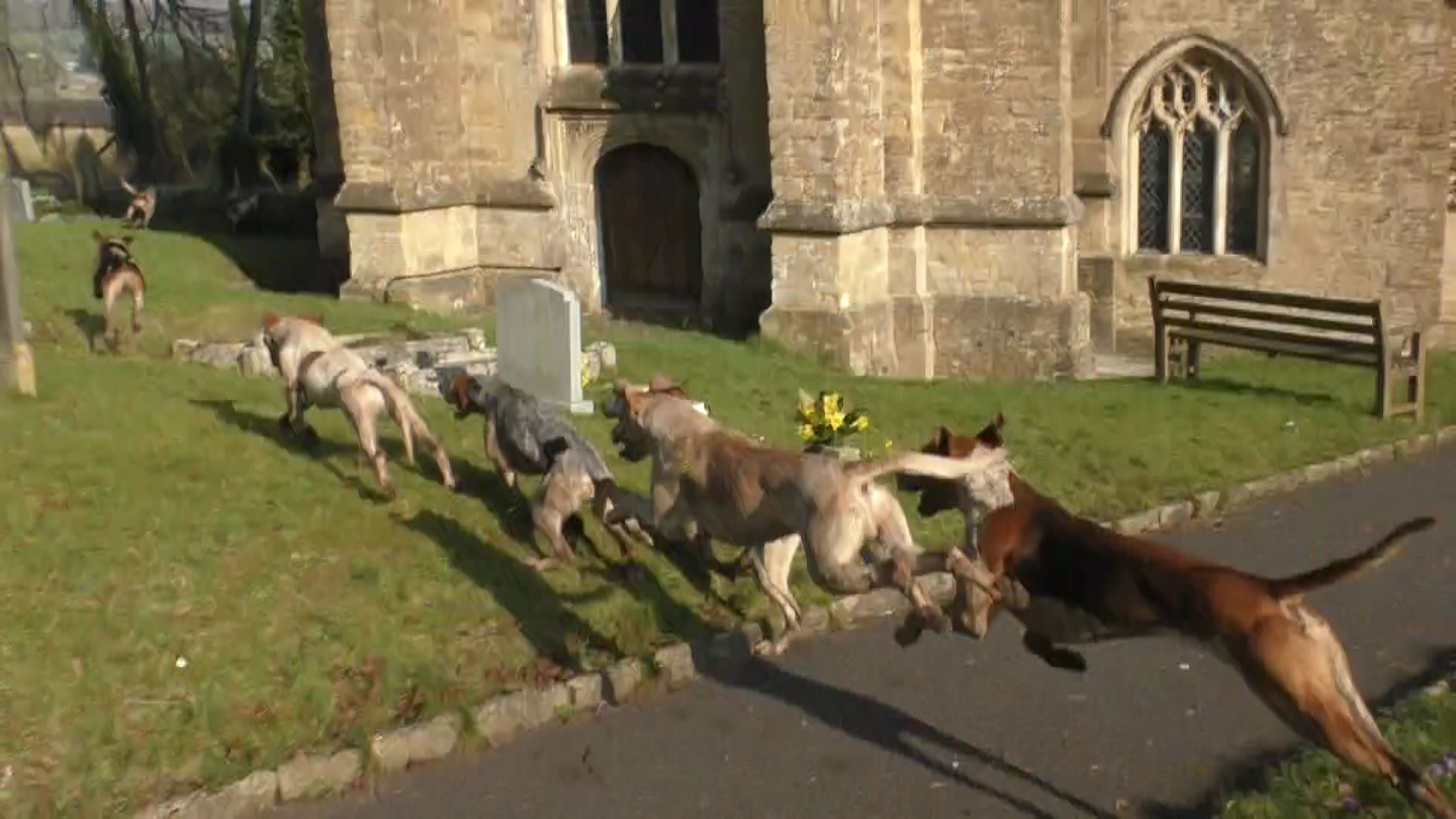 Blackmore & Sparkford Vale Hunt hounds hot on the trail of a nursing vixen in St Peter & St Paul's Churchyard, Charlton Horethorne, Somerset on 23.02.19 Photo: Kevin Hill/Hounds Off/Somerset Wildlife Crime
Blackmore & Sparkford Vale Hunt hounds hot on the trail of a nursing vixen in St Peter & St Paul's Churchyard, Charlton Horethorne, Somerset on 23.02.19 Photo: Kevin Hill/Hounds Off/Somerset Wildlife Crime
HOUNDS OFF PRESS RELEASE MON 25 FEBRUARY 2019
- Hunters in Somerset were forced to call their hounds off a female fox because anti hunt monitors recorded the whole incident on film.
- At about 2pm on Saturday 23 February 2019 the Blackmore & Sparkford Vale Hunt chased the vixen through private gardens and the churchyard of St Peter & St Paul’s in Charlton Horethorne, just a stones throw from the hunt kennels. But Somerset Wildlife Crime and Hounds Off Monitors, equipped with video cameras, were at the scene and recorded it.
- Wildlife rescue expert Penny Little (tel: 07702 565598) reviewed their footage. She said, “I am confident this hunted fox is a vixen that has recently given birth to cubs as her teats are visible and show clear evidence of lactation.”
- WATCH SOMERSET WILDLIFE CRIME / HOUNDS OFF FILM HERE
- Footage shows a fox being hunted through gravestones and into bushes where by some miracle it gives chasing dogs the slip. Campaigners film also documents the moment when the nursing vixen tries to steal away unseen and is “hollered” by a member of the hunt (a loud, high-pitched yell to inform the Huntsman and his hounds that the fox has been spotted).
- Bobbie Armstrong (tel: 07572 495309) from Somerset Wildlife Crime said, “When the fox crossed in front of us we told a red-coated hunter to call hounds off. At this point they were right on her and it looked grim but the red-coat knew we had it all on film. He had little choice but to call hounds back and let the fox get away. It was all a bit tense for a while but we were pleased to be in the right place at the right time.”
- Foxhunting has been illegal in England and Wales since 2005 but hunts continue, claiming to chase a trail which they lay in advance. The “accidental” hunting and killing of foxes during so-called ‘trail hunts’ is commonplace and the law remains powerless to prevent this.
- Hunt Monitor Kevin Hill (tel: 07971 633182) said, “It seems pretty obvious that the Blackmore & Sparkford Vale Hunt were cheerfully and deliberately chasing foxes on Saturday and if we had not been there then they’d have got away with it. Think about it for a second. Who in their right mind would lay a trail through private gardens and a churchyard?”
- Bobbie Armstrong said she had spoken to the Reverend Sarah Godfrey, the Vicar at Charlton Horethorne. According to Ms Armstrong, “She wasn’t aware of the events of yesterday and was keen to see our evidence. The Vicar was grateful to be informed.”
- Hounds Off specialises in giving help, support and advice to farmers, landowners and rural residents affected by hunt trespass. Joe Hashman, Founder, said, “We can help the Reverend Godfrey if she wants to make the churchyard into a hunt-free wildlife sanctuary. All she needs to do is visit the Action & Advice pages of our website or ask us. The same goes for anyone else, anywhere in the country.”
- Somerset Wildlife Crime and Hounds Off Monitors did not see anyone laying trails, or even pretending to lay trails, at any time throughout the day.
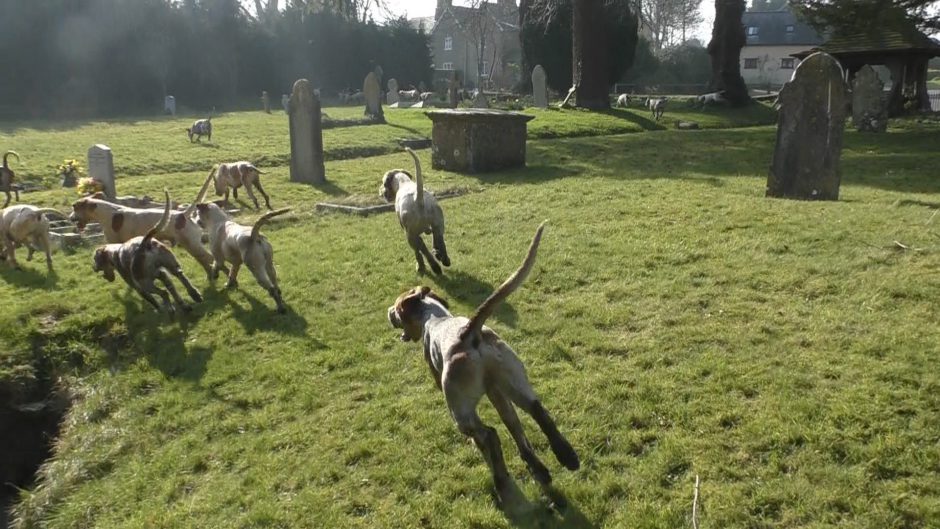
Blackmore & Sparkford Vale Hunt hounds invade St Peter & St Paul’s Churchyard in Charlton Horethorne on 23.02.19 in persuit of a live fox. Photo: Kevin Hill/Hounds Off/Somerset Wildlife Crime
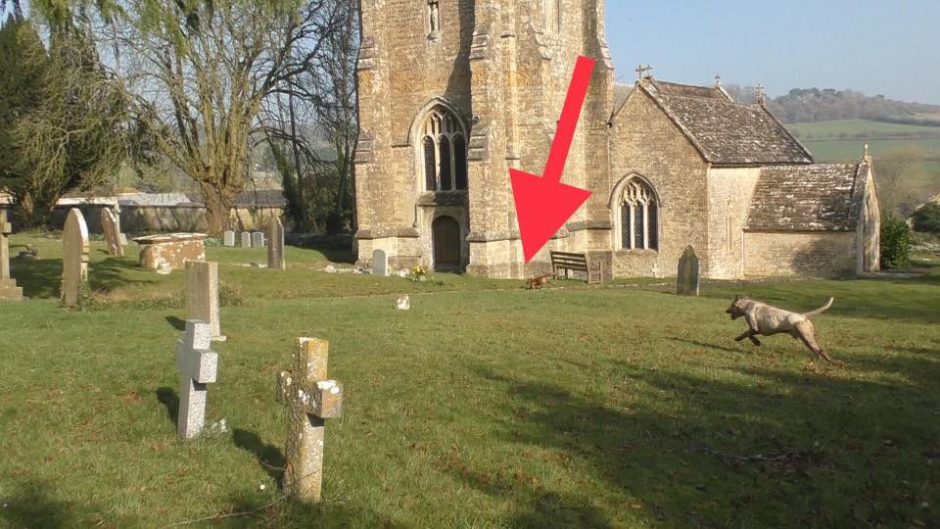
Fox is chased with dogs across St Peter & St Paul’s Churchyard in Charlton Horethorne, Somerset, 23.02.19 by the Blackmore & Sparkford Vale Hunt. Photo: Kevin Hill/Hounds Off/Somerset Wildlife Crime
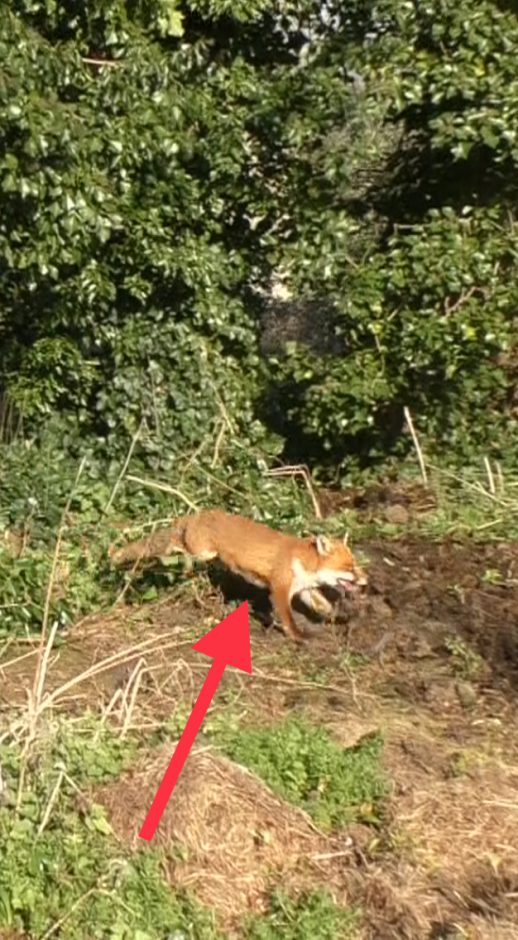
A significant undercarriage is a telltale sign that this hunted vixen was nursing young cubs underground nearby. Photo: Kevin Hill/Hounds Off/Somerset Wildlife Crime
NOTES
In recent weeks the Blackmore & Sparkford Vale Hunt;
- was supposedly ‘trailhunting’ beside and across the busy A352 until after dark on February 19 2019.
- killed a fox ‘accidentally’ on February 9 2019.
- carried on hunting with horses and hounds two days after equine flu was confirmed at a local riding stables.
IF YOU WOULD LIKE TO SUPPORT OUR WORK PLEASE BUY US A KO-FI;
- Somerset Wildlife Crime
- Hounds Off
18th October 2018
Government Defends Wildlife Crime On Public Land
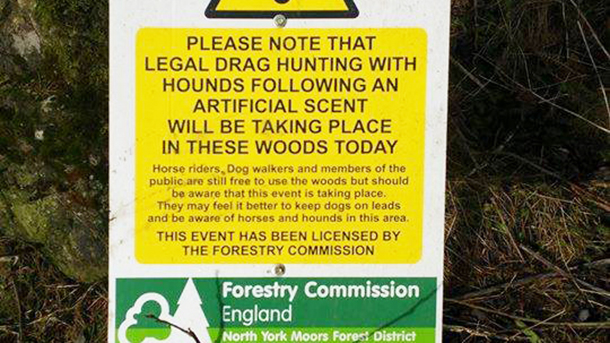 Forestry Commission sign warning of a 2016 drag hunting event at North York Moors, where no actual drag hunt operates. Photo courtesy International Fund for Animal Welfare
Forestry Commission sign warning of a 2016 drag hunting event at North York Moors, where no actual drag hunt operates. Photo courtesy International Fund for Animal Welfare
GOVERNMENT DEFENDS WILDLIFE CRIME IN PUBLICLY OWNED FORESTS
Yesterday, the Department for Environment, Food & Rural Affairs responded to a petition calling for an end to the licensing of so-called ‘trail hunts’ on the Public Forest Estate, which is owned & managed by the Forestry Commission on behalf of the public. The response is pretty much a paraphrased Countryside Alliance press release and there are a couple of things they’ve either overlooked, perhaps accidentally, perhaps not:
- The petition specifically doesn’t call for an end to licences given to hunts which have agreements formed under a general agreement with the Master of Draghounds & Bloodhounds Association (MDBA), as drag hunting & clean boot hunting are not covers for wildlife crime.
- DEFRA’s response omits that licences are also granted to hunts under a general agreement with the Association of Masters of Harriers & Beagles (AMHB), such as the New Forest Beagles.
Most importantly, though, they’ve regurgitated one of the most worn out lies in the country and they’ve done so without scrutiny. This is, of course, that fox & hare hunts have stopped hunting live quarry and started to ‘trail hunt’.
‘Trail hunting is a legitimate activity … Many hunts have since turned to trail hunting as an alternative to live quarry hunting…’ – DEFRA, 17th October 2018.
Here’s a couple of brief reasons why this is rubbish:
- In 2014, a review of RSPCA prosecuting activity was published by Stephen Wooler CB, a former Chief Inspector for the Crown Prosecution Service. On P109/s9.1 it stated that: ‘The evidence reviewed leaves no room for doubt that, despite the 2004 legislation, traditional fox hunting remains “business as usual” in many parts of the country.’
- Both before & after the Wooler Review, hunts that have been licensed to use public land by the Forestry Commission have been convicted; the Meynell & South Staffordshire Hunt were convicted under the Hunting Act 2004 based on footage from Derby Hunt Saboteurs and the Cottesmore Hunt were convicted under the Protection of Badgers Act 1992 based on footage from the League Against Cruel Sports.
DEFRA have rejected the requests of the petition on a completely false premise. It remains open & ongoing to gain signatures, and needs 100,000 signatures before 18th March 2019. If you haven’t signed this already, please do so here!
© Jack Riggall
13th October 2018
Game Of Cat & Mouse Continues #TrailHuntLies
HOUNDS OFF OPINION
The National Trust has started issuing licences for foxhunt packs to carry out so-called trailhunting on their land. But this season the business-as-usual status quo has changed slightly. Licences will now be open to public scrutiny and a small team has been appointed to oversee this activity. For many this is not enough, for others it’ll be too much.
Myself, I’m a realist. I know the National Trust is a huge chuntering juggernaut of a conservation charity which must cater for a wide spectrum of opinions and beliefs. I know how frustratingly slow it can be to effect positive change but I also recognise that the National Trust has a history of being led by its Members and it is always worth using your voice and your vote.
So it was that on Friday 12 October I travelled to Birmingham and, with Jack Riggall from National Dis-Trust, met with Nick Droy and Rob Rhodes from the National Trust. Nick is five weeks into his role of Trailhunting Manager and Rob (who attended via telephone) is the Head of Countryside Management & Rangers.
Trailhunting Manager is a new post, created by the National Trust in response to concern from Members and the public that trailhunting is nothing more than a false alibi used to provide a cover for illegally chasing and killing wild mammals with dogs.
Nick told us that his professional background is in practical countryside management at both regional and national levels and it started eighteen years ago when he was himself a National Trust volunteer. He explained that he has no hunting in his background and is approaching this complex issue with a fresh eye and open mind.
Nick will lead a team of three; an office-based co-ordinator and a worker who will assist in carrying out face to face engagements, checks in the field and monitoring of so-called trailhunting on National Trust land.
This season, the Trailhunting Team will be conducting one pre-arranged inspection of each Hunt which is granted a licence by the National Trust. My problem with this is that it provides an easy way for #TrailHuntLies to avoid detection because when Nick is about Hunts will temporarily change the way they behave.
I told Nick and Rob this and referred them to a 2015 report called Trail Of Lies. It is a fantastically complete and in-depth exposé of how Hunts have used trailhunting to circumvent the law, to carry on abusing and killing. The only problem with Trail Of Lies is that it was complied and produced by the International Fund for Animal Welfare and so hunters consider it to be propaganda.
It is not and, to reinforce the point, I signposted the National Trust Trailhunting Manager to another, independent, source which reaches the same conclusion; the Wooler Review.
What happened was the RSPCA had grasped the nettle in terms of taking private Hunting Act prosecutions and landed seminal convictions against the prestigious Heythrop Hunt in 2012. The Countryside Alliance went ballistic and set out to destroy their opponents.
Their criticism reached a crescendo in January 2013 when former Countryside Alliance head honcho Simon Hart MP initiated a debate in the House of Commons about prosecutions brought by the RSPCA and in response Her Majesty’s Attourney General suggested that an independent review could be advantageous. The RSPCA Council took heed and appointed Stephen Wooler CB to do this. Wooler is a Barrister and former Chief Inspector to the Crown Prosecution Service.
During our meeting I read a passage from the Wooler Review and asked Nick to think of his Trailhunting Team as being the police officers to which Wooler refers;
“Securing the evidence neccasary to mount effective prosecutions under the Hunting Act 2004 in respect of mainstream foxhunting therefore requires far more than sending a team of police officers to take the names and addresses of those at a hunt gathering. The evidence required is such that it is unlikely to be achieved through police presence and observations alone since behaviours would then be likely to change.” (1)
In fact, Wooler goes on to describe a “cat and mouse game between hunting participants and supporters and those endeavouring to gather evidence through observations and recordings.” (2)
I concur with Wooler (2014) and Trail Of Lies (2015): giving hunters a heads-up when they’ll be monitored on National Trust land is rather like the police telling a burglar when they’ll be round to look for stolen goods.
As Trailhunting Manager, it is part of Nick Droy’s job description (and background research) to meet with the likes of Jack and myself. I found him to be friendly, open and likeable. That’s a good start, but I do believe that there are fundamental flaws in how the National Trust have instructed him to carry out his duties. We agreed to keep lines of communication open and meet again next summer. Doubtless much will happen between now and then.
© Joe Hashman
References:
(1) The independent review of the prosecution activity of the RSPCA, Stephen Wooler CB, 2014. Page 110, paragraph 5.
(2) The independent review of the prosecution activity of the RSPCA, Stephen Wooler CB, 2014. Page 110, paragraph 6.
Hounds Off is run by volunteers. We rely on public support to fund our work. If you would like to contribute .
Costs incurred on 12 October 2018;
Return travel by road from Dorset to Oxford (179 miles at 44 pence per mile) = £78.76; Oxford to Birmingham New Street return, by train (Adult Standard Class) = £79.20; Total = £157.96
2nd September 2018
Hunts On Roads - #NoExcuse
One of the most extraordinary photos Surrey Hunt Monitors has taken is of Morestead Road, near Winchester. It’s an unremarkable road, but at about 2.15pm on Saturday 27 January 2018 it looked like a canine racetrack.
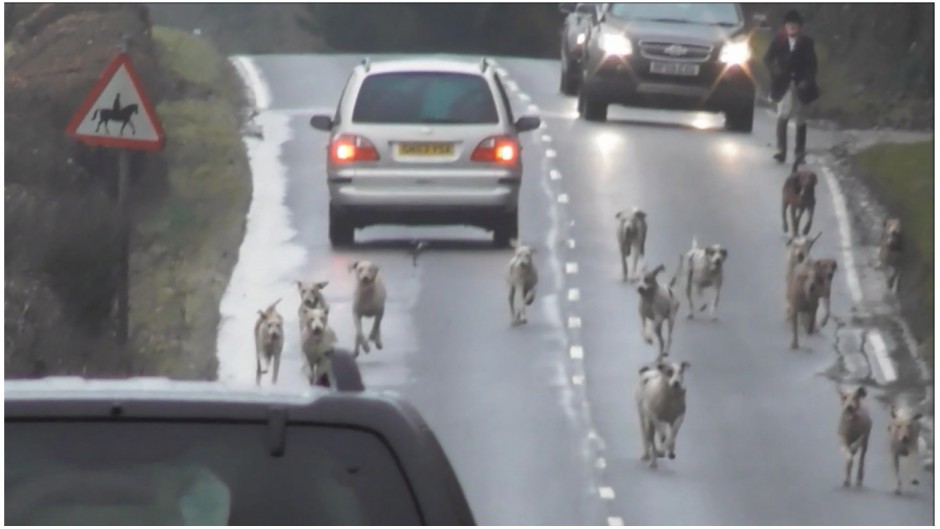
Funny old place to lay a trail. It would be almost as stupid as on the A1(M) motorway in North Yorkshire (28 January 2017), or through a cat sanctuary in Kent (9 January 2018).
Of course it wasn’t actually the case that a trail was laid in any of these places. In each case the hounds had been following animal scents. In the Morestead Road case, the scent was of two deer which had been chased by the hounds and had crossed the road a short while before.
What happened next was referred to on Twitter as #HuntHavoc. It’s a very appropriate term. It risks lives, not just of the animals being chased and the hounds doing the chasing, but also the people driving on the roads who, at any moment can find themselves in the wrong place at the wrong time, like the driver of this car who had to make an emergency stop and swerve to avoid one of the Morestead Road hounds as it emerged from the undergrowth along the side of the road and into his path:
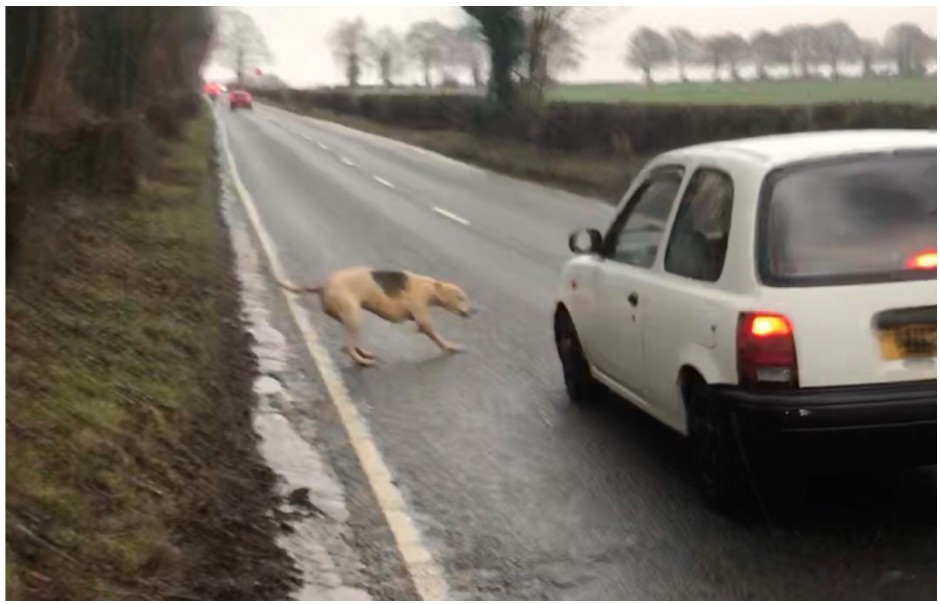
For a video of this on Twitter see here.
A driver cannot help his or her instincts. See a dog run out in front of you, and you will do as he did and swerve as well as brake. If a car had been coming the other way, a very nasty collision could well have occurred.
So whose fault would it have been? Not the driver’s, but the owner of the hound. And that’s because dogs on roads are inherently dangerous that the Road Traffic Act 1988 contains a provision - Section 27, subsection (1) - which makes it a criminal offence to cause or permit a dog to be on a road without the dog being held on a lead.
So isn’t it obvious then, that the owners of hounds which go on roads are committing an offence? Actually, no. As with all legal issues connected with hunting, its not so simple as that. The hunting lobby had powerful friends in Parliament when this Act was passed and they ensured an exception for hunts. It reads: “subsection (1) … does not apply to dogs proved … to have been at the material time in use under proper control for sporting purposes”. Hence it is perfectly legal, whilst out hunting, for a pack of well-behaved hounds to trot along a country lane with the hunt in the classic picture-postcard image hunts like to portray.
But the key words for this purpose are “under proper control”. In what possible sense is a hound under proper control if it is on a public road chasing a fox or deer? In the Morestead Road case, it was such a clear cut situation that the local (Hampshire) police investigated and interviewed the relevant hunt, the Hursley Hambledon Hunt. The matter appears to be nearly resolved with a Community Resolution Order, meaning that the hunt accepts responsibility and writes a letter of apology. Whilst not a conviction, it is a step on that road (if the pun will be forgiven) and the Hursley Hambledon Hunt will have to be much more careful in this coming season, since the next offence would likely mean a caution, and the one after that a court appearance.
The “squeeze”
However, there can be other cases where it is arguably not so clear. The hounds may not be on the road for so long, for example, with the hunt arguing the hounds were in fact under control. This is when what lawyers like to call a “squeeze” can be brought into play.
Consider a case where a hunt is accused of unlawful hunting under Section 1 of the Hunting Act 2004. The defence is invariably of “accident”: the hounds were following a trail when they just happened to come across a fox and chased it. The recent Grove and Rufford and Portman Hunt cases are just two examples. Hounds could not be called back (despite best efforts, of course). Or the huntsman was not sufficiently close to the hounds to be in control and hence responsible. But if the huntsman was not close enough to control his hounds, or was close, but not able to control them, and they cross a road, the Section 27 offence surely cannot be avoided: there is a “squeeze” between the two offences. In order to escape the Hunting Act offence, the hunt is inescapably admitting (indeed positively claiming) a lack of control and hence the commission of an offence under the Road Traffic Act.
Hound exercise
Another activity undertaken by hunts is “hound exercise”. This is in principle an unobjectionable behaviour in as far as the hounds are simply taken out for a run. If only hunting were replaced entirely by hound exercise! However, hounds need exercise every day and it must be a significant effort to put them in a van and drive them to somewhere safe to get this. Hence it’s not surprising that some hunts use roads to access nearby fields.
The question is, does the hunting exemption then apply? The clear answer is “no”. To repeat, the relevant language of the defence is (emphasis added): “subsection (1) … does not apply to dogs proved … to have been at the material time in use under proper control for sporting purposes”. The fact the hounds are used three times a week for hunting is of no relevance to the other four days of the week. There is no blanket exemption for foxhounds. When hounds are being taken out for exercise and use a road they must, like any other dog, be on a lead, or else an offence under Section 27 of the Road Traffic Act will be committed.
Some hunts are worse again and do not even bother to take the hounds to a field. One example local to Surrey Hunt Monitors is the Hampshire Hunt. They’re based in a quiet village called Ropley and here one can often see the entire pack being led around the village roads by three cyclists causing chaos:
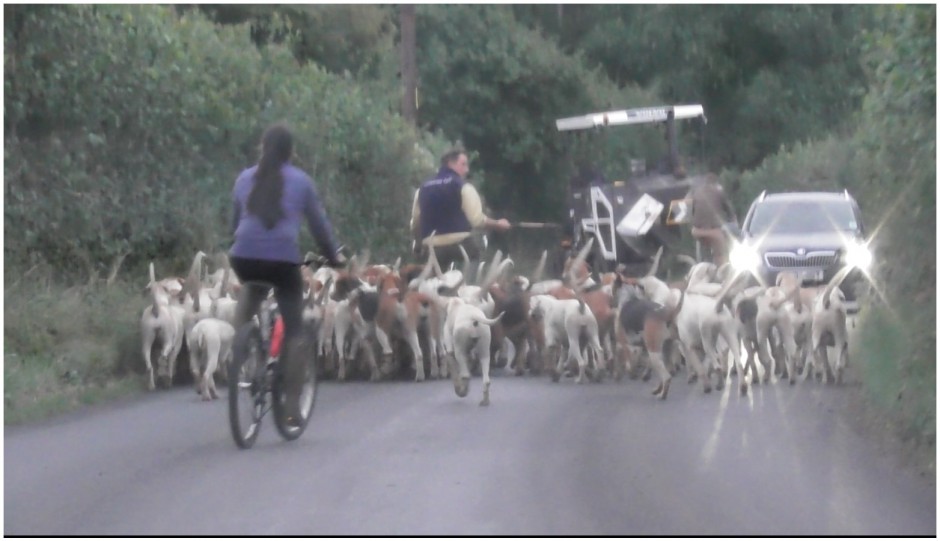
… not to mention depositing a large amount of dog mess …
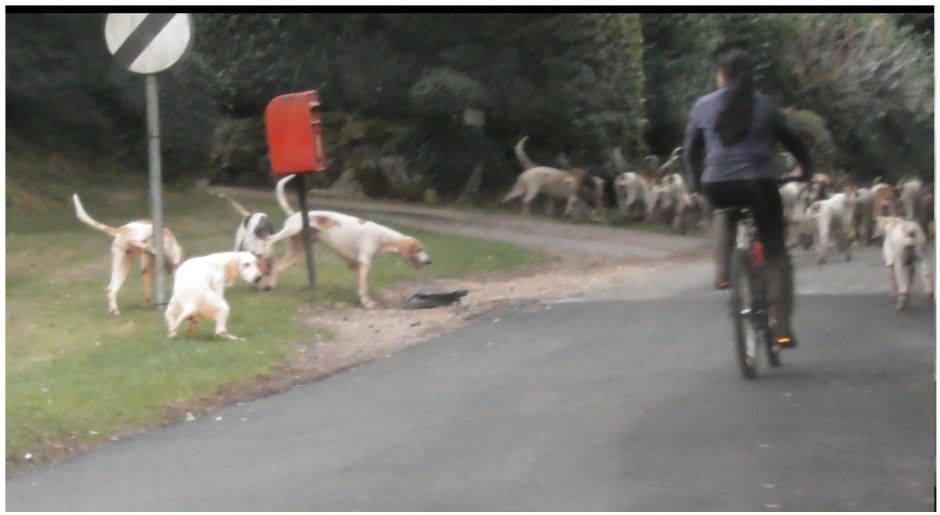
Two sample incidents have recently been reported to Hampshire police, and we await hearing from them as to if and how they intend to proceed.
Advice for Campaigners and the Public
Convictions under the Road Traffic Act are distinctly second best to Hunting Act convictions, but given the difficulty of the latter, they represent a way forward in controlling the reckless behaviour of hunts. So we offer two bits of advice;
1. If you are out early one morning hoping to catch your local hunt cubbing and only see them exercising their hounds on the local roads, dial 101 and report them under S.27 Road Traffic Act 1988. If the police say hunts are exempt, put them straight.
2. On hunt days, when hunt hounds cross a road in pursuit of a fox or deer, report both illegal hunting and the RTA offence and the chances are the hunt will walk straight into the “squeeze”. Let’s at least stop #HuntHavoc before an innocent person is killed in addition to the thousands of innocent foxes who die every year in so-called trailhunting “accidents”. After all, there is #NoExcuse.
© A Surrey Hunt Monitor
5th August 2018
The Fell Packs & #TrailHuntLies in Cumbria
As part of the wider National Dis-Trust campaign which started in Cumbria, we’re adding this to Hounds Off as a reference point for you to learn more about the fell packs, their abuse of wildlife, and why we’re calling for them to be permanently banned from National Trust land. All of the fell packs were either licensed to use Trust land for the 2017/18 season or given free reign to trespass and kill foxes. Here are a few of the ‘highlights’ of their history (click the links to learn more)…
- In November 2017, the Eskdale & Ennerdale Foxhounds were documented trespassing on National Trust land with terriermen, but subsequently received a licence anyway.
- On 06/09/2017, a representative of the fell packs told the BBC that numerous foxes are ‘accidentally’ killed each season.
- At the Peterborough Hunting Festival on 19/07/2017, huntsman for the Blencathra Foxhounds stated that his hounds can sometimes be unsupervised up to five miles away, meaning nobody knows what they are doing or what they might be killing.
- A supporter of the Melbreak Foxhounds attacked a member of Lancashire Hunt Saboteurs on 10/01/2017 who then needed hospital treatment. The hunt supporter was convicted of assault.
- The Melbreak Foxhounds supplied a fake certificate to the Trust dated 23/10/2016 to help gain a licence, and were granted further licences to use Trust land long after the lie was exposed.
- The Melbreak Foxhounds were filmed killing a fox on Trust land by Cumbria Hunt Watch on 05/11/2015.
- On 15/03/2014, the Ullswater Foxhounds were filmed killing a fox before attacking a hunt monitor, resulting in a conviction for assault.
- The Melbreak Foxhounds killed a fox on 09/03/2014 after chasing it across Trust land, resulting in a police investigation resulting in charges and the subsequent intervention of a member of House of Lords trying to defend the huntsman.
- The Blencathra Foxhounds were investigated for illegally hunting & abuse of hunt monitors in 2013.
- On 24/03/2012, walkers witnessed the Coniston Foxhounds killing a fox and police investigated claims that hunt supporters seriously attacked protestors.
- The News & Star reported on 09/01/2012 about hunting forum users allegedly admitting to illegal fox hunting whilst with the Blencathra Foxhounds.
- A supporter of the Coniston Foxhounds attacked a League Against Cruel Sports investigator on 09/03/2010, receiving a police caution.
- The terrierman for the Ullswater Foxhounds was convicted under the Hunting Act 2004 after digging out & beating a fox to death on 26/10/2009, after it had gone to ground. He continued to be employed by the Ullswater Foxhounds, which continued to be licensed by the National Trust.
- The Ullswater Foxhounds huntsman was in court on 17/09/2009 after a fox was killed by his hounds.
- Huntsman for the Coniston Foxhounds was convicted for criminal damage after smashing the windows of a hunt monitor vehicle on 19/02/2008.
- The Blencathra Foxhounds are believed to have killed a fox on National Trust land on 11/02/2006.
WHAT CAN YOU DO ABOUT THIS?
- Ask the Trust’s General Manager for Central & East Lakes firstly why the Melbreak have only been suspended, not banned, and secondly for him to stop offering licences to all fox hunts in Cumbria. His email is [email protected].
- If you live in Cumbria and want to volunteer for our campaign, please email us at [email protected] for packs of leaflets specific to Cumbria to deliver/hand out.
- Sign the Keeptheban petition to ban all hunting on National Trust land in England & Wales.
- Grass up the Cumbrian hunts if you see them by emailing Cumbria Hunt Watch on [email protected].
- Follow National Dis-Trust on Facebook and Twitter for updates.
© National Dis-Trust
26th February 2018
Trail Hunting - A Nationwide Criminal Conspiracy
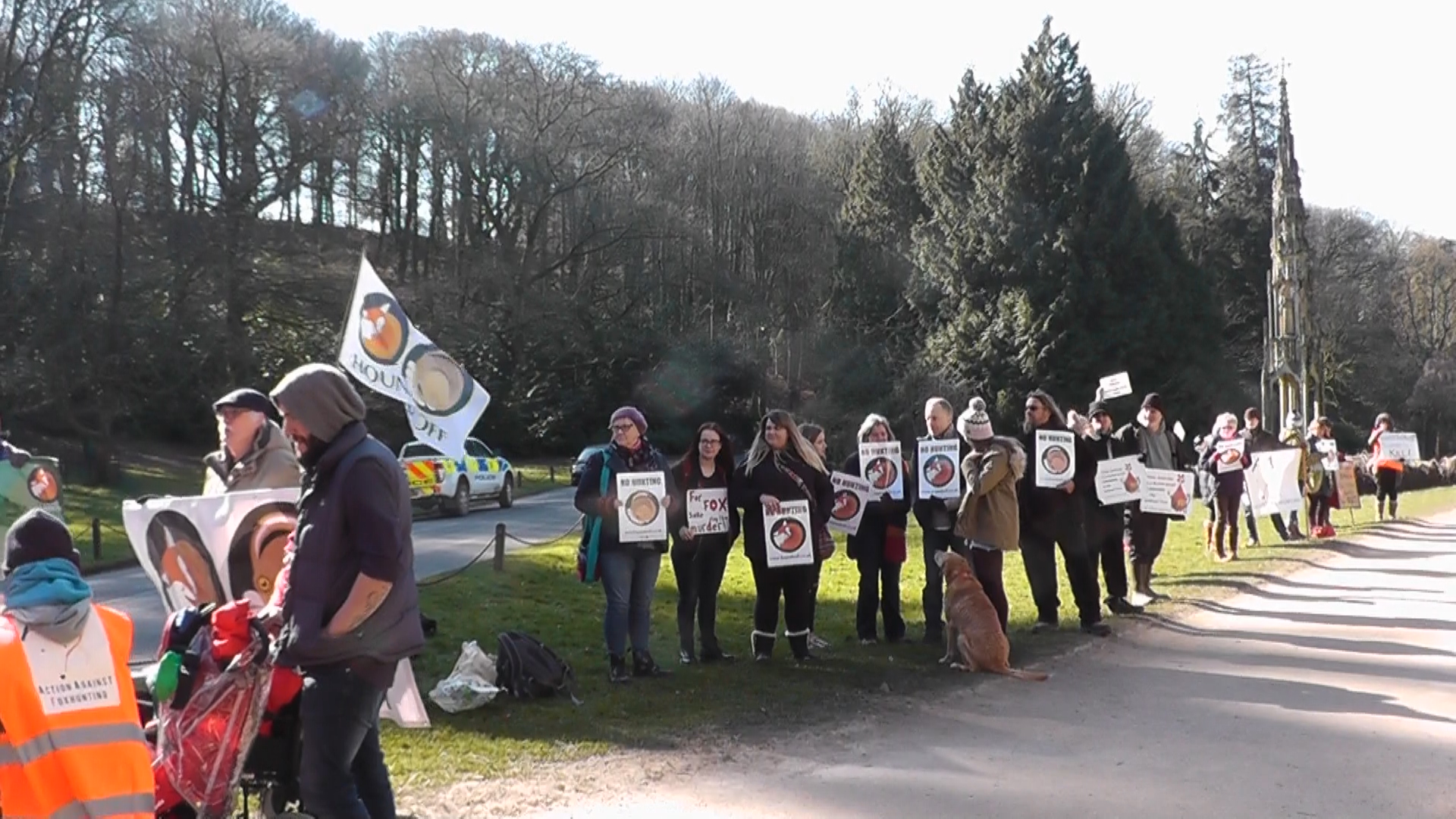 Campaigners continue to expose #TrailHuntLies & lobby the National Trust to stop issuing licences to kill fox, hare, deer & mink on their land for so-called 'sport'. Here, at Stourhead in Wiltshire on 25 Feb 2018 as part of a day of similar protests at NT sites around England, co-ordinated by the National Dis-Trust. Pic: Hounds Off
Campaigners continue to expose #TrailHuntLies & lobby the National Trust to stop issuing licences to kill fox, hare, deer & mink on their land for so-called 'sport'. Here, at Stourhead in Wiltshire on 25 Feb 2018 as part of a day of similar protests at NT sites around England, co-ordinated by the National Dis-Trust. Pic: Hounds Off
Trail hunting is a myth, a ruse invented by the hunting community to enable them to continue abusing wild mammals with dogs for sport.
Trail hunting was invented on the day the Hunting Act (2004) came in to force. It has been used as a false alibi to cynically subvert the law ever since. There is no trail hunting governing body, there are no written rules and regulations to which participants must abide. How to conduct a so-called trail hunt is left up to each individual hunt to decide.
Trail hunting is billed by the Countryside Alliance and their allies as a temporary activity which sustains the infrastructure of hunting until such time as the law banning bloodsports is repealed. One of the main tenets of this charade is the principle that the scent which is laid for hounds to follow is based on their traditional quarry. They say that this will enable them to switch back to fox, hare, deer and mink hunting at the drop of a hat because their hounds won’t need retraining. We say that this pretence enables them to “accidentally on purpose” harrass and kill live animals. Nobody, not even the National Trust, is denying that “accidents” happen.
In 2017 the National Trust introduced some changes in the rules they claim hunts must obey in return for a licence to trail hunt on NT land. The first of these is banning the use of animal-based scents as a trail for hounds to follow.
“This will reduce the risk of foxes or other wild animals being accidentally chased,” the NT tells us. Alas, it’s a nonsense.
Hunts continue to train their hounds to hunt the scent of their traditional quarry, not something else. You cannot have a situation where a hunt goes after a fox-based scent on private land on Monday, then an artificial scent on NT land on Wednesday. Hunting a pack of hounds doesn’t work like that. Training a them to be steady and reliable on one thing takes time and effort. And who’s checking anyway? Not the NT. They’re happy to let hunts self-regulate.
We believe that everybody who follows so-called trail hunts, save newcomers, children and the terminally naive, knows that trail hunting doesn’t really exist. Sure, somebody might trot around with a duster on the end of a whip as lip service to a ‘trail’ for the benefit of show, or if the press or cameras are present. But away from outsiders, out of public gaze, hunting wild mammals with dogs for sport continues much as it did in the last century. There is, we suggest, a nationwide criminal conspiracy to facilitate this animal abuse. It’s tragic that the National Trust Ruling Council chooses to collude.
© Joe Hashman
5th January 2018
The Politics Of Hunting (free event): Tues 9 Jan, Alton, Hants
Questions & queries via our Contact Us page or social media platforms. Thankyou.
27th August 2017
Calling All National Trust Members #TrailHuntLies
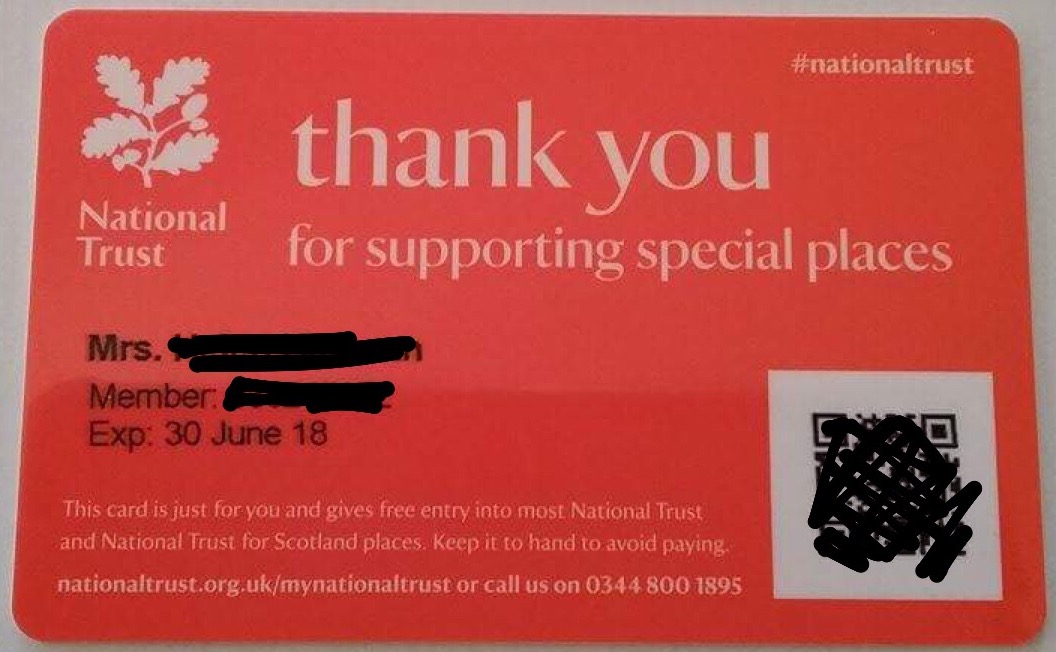 National Trust members will be voting whether or not to properly prohibit illegal hunting on its land at the AGM on Oct 21st 2017. Hounds Off urges all members to vote against bloodsports and false alibis.
National Trust members will be voting whether or not to properly prohibit illegal hunting on its land at the AGM on Oct 21st 2017. Hounds Off urges all members to vote against bloodsports and false alibis.
If you belong to the National Trust then you may be aware that there’s a big vote coming up for members to decide whether or not to stop illegal hunting on NT lands. The vote takes place at the AGM in Swindon on October 21. It’s important because after twelve years of hunts riding roughshod over the law and public opinion, and decades of hunts abusing our wildlife and damaging delicate habitats, you’ve a chance to cast a vote which says “No hunting, enough is enough”.
The reason why you’re able to vote now is because of a resolution before NT members. According to our sources, this is it:
“That the members agree that The National Trust will not permit trail hunting, exempt hunting & hound exercise on their land, to prevent potential illegal activity in breach of The Hunting Act 2004 & The Protection of Badgers Act 1992 and to prevent damage to other flora & fauna by hunts, their hounds, and their followers.”
Don’t be confused by terms like trail hunting, exempt hunting or hound exercise. These are just false alibis for illegal fox, hare, deer and mink hunting. It’s what the hunters say they’re doing so they can cynically circumvent the law and carry on killing on the sly. Your vote for the resolution will create hundreds of thousands of hectares of land where wild mammals can find safe sanctuary away from a minority of cruel and/or ignorant people who want to hunt them with dogs and kill them for fun.
Trail hunting is the commonest false alibi. It’s been used by most fox and hare hunts around the country for the last twelve years. Having been complicit in the whole trail hunting charade, or maybe just not being aware, the NT recently changed the conditions it imposes for licensing so-called trail hunting on its land. We think this a move in the right direction but fundamentally misses the point, which is that trail hunting doesn’t really exist. The International Fund for Animal Welfare published a complete exposé of trail hunting in a report called Trail Of Lies (Casamitjana, 2015). If you’re in any doubt about what you’re reading here then please, take a look.
Exempt hunting is how staghunters in the West Country get away with continuing their sport. They supposedly use two hounds running in relays, plus an army of people with vehicles and horses, to chase deer to an exhausted standstill so they can kill them and then conduct bloodthirsty celebration rituals.
Under certain conditions it is legal to stalk and flush wild mammals with two dogs. But staghunters abuse both word and will of the law and, as if to poke their tongues out as well as two fingers, often claim to be conducting simultaneous ‘scientific research’.
Back in 1997 the NT actually banned staghunting on its land and for a very good reason - staghunting causes extreme and unnecessary suffering. In response to concern from members, the NT commissioned an independent scientific study into the welfare implications of hunting red deer with hounds. From this it was concluded that the negative effects of hunting on deer were so severe that the NT banned it the day after publication. However, there is much evidence to suggest that, to this day, in parts of Devon and Somerset deer are still hunted on ground where they should be able to live in peace.
Hound exercise is a pretence for a particularly barbaric and sick practice, originally called Cub hunting (later sanitised to Autumn hunting). Hound exercise is a ruse for when foxhounds are trained to find, hunt and kill foxes as a pack. You’d be forgiven for reading the words “hound” and “exercise” and not thinking of fox families being split up and massacred by people with packs of dogs in the countryside, but that’s the idea.
The hunting community has been skilfully using words to create smokescreens and disguise their illegal intentions since the Hunting Act passed into law twelve years ago. Now it’s time to call time on their deceptions, confusions and #TrailHuntLies.
Members, your AGM/voting packs will be with you by mid-September. Please vote by proxy, online or in person on Oct 21 for the National Trust to prohibit trail hunting, exempt hunting and hound exercise on their land.
To be continued….
© Joe Hashman
28th May 2017
The Magic Of Hares
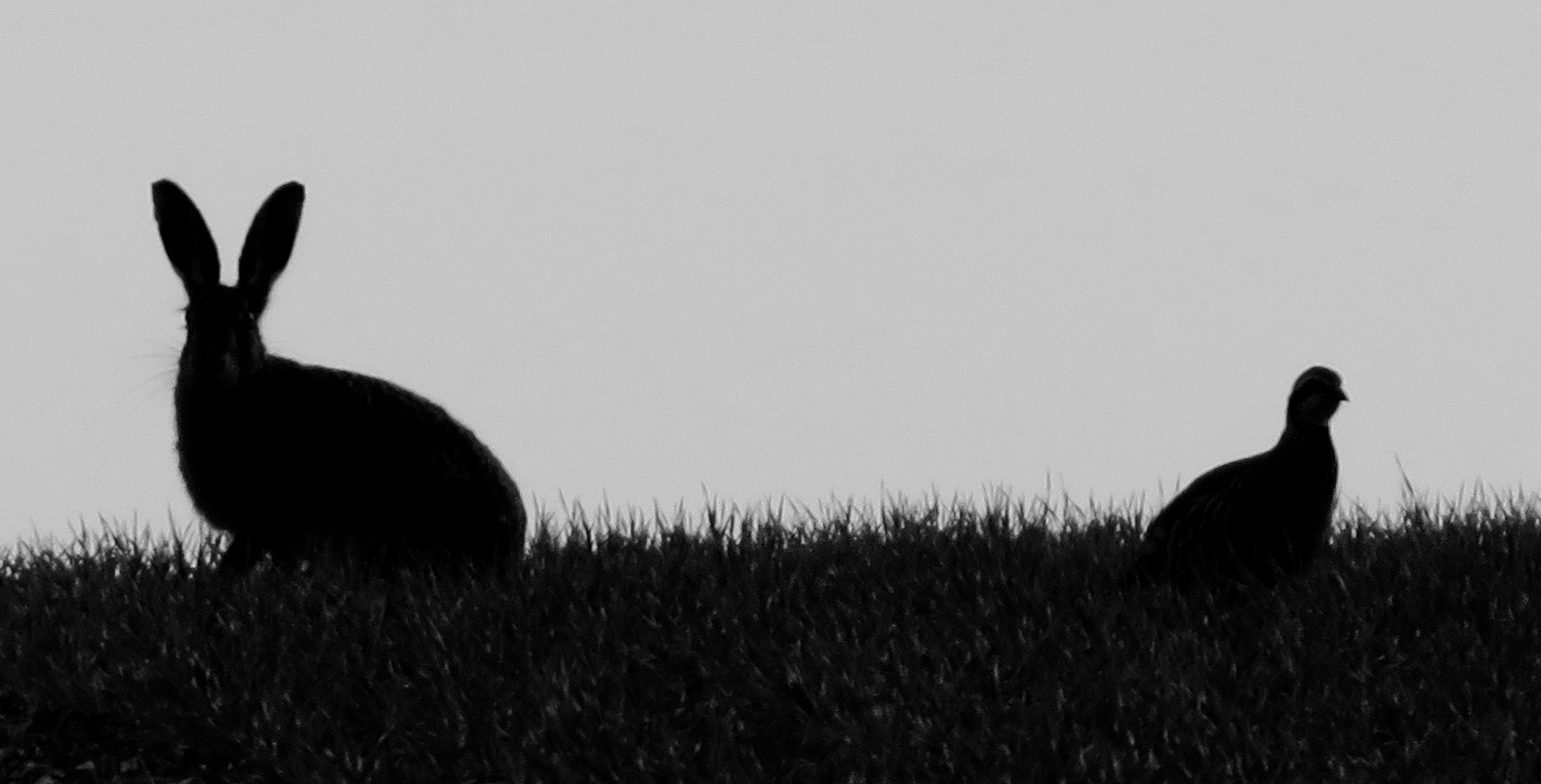 Hounds Off is grateful to Brigit Strawbridge for her permission to use this 2017 photograph.
Hounds Off is grateful to Brigit Strawbridge for her permission to use this 2017 photograph.
The Hare Preservation Trust invited Hounds Off Founder, Joe Hashman, to write the The Magic Of Hares to mark the occasion of their 2017 Annual General Meeting & HareFest which took place at Aldeburgh in Suffolk on Saturday 28 May:
THE MAGIC OF HARES
It’s hard to know how to properly explain what I think about hares.
It’s not enough to say, “They’re amazing creatures, magical, beautiful, I love ’em, look at their ears, those legs, you wanna see them moving, they’ve got wild eyes.” Words don’t adequately convey my feelings towards hares, or how they pull on my heart strings and stir emotions which always feel deep.
I do love hares. I love hares that I see doing their thing in passing fields beyond the windows of a car, I love hunted hares which I worry about and desperately want to escape, and I love all the hares in between.
My first encounter with a live hare was when I was in my early teens, while travelling on a West Oxfordshire backroad to play an evening tennis match. She was large and upright, poised on the tarmac ahead, then gangly but strong, powerful, poetic as she ran.
It was a straight and open stretch of single track lane so we were treated to an extended view. My Mother slowed to an appropriate speed so we could safely but closely see this almost unbelievable creature. Then, in a bound, she was gone, jinking right-handed into the luxuriant verge.
This hare made quite an impression. In that moment her species lept off the butchers shop meat hooks in Oxford’s Covered Market, out from pages of natural history books in the school library, and into my life.
I was upset to learn that hare hunting with dogs was considered to be good sport by people who did it to keep themselves entertained.
AN INTRODUCTION TO HARE HUNTING
My next hare encounter was with the Oxford Polytechnic Hunt Saboteurs Association. They were an effective and experienced bunch. I was a 14-year old local kid but the student hunt sabs took me under their wing in almost parental fashion. They taught me well.
It was early January 1983. We parked in the middle of nowhere and walked cross-country to a remote Buckinghamshire railway hamlet called Verney Junction to catch the Old Berkeley Beagles by surprise. Elderly folk leaning on sticks and gazing into fields gave us clues where the sharp end of the hunt was, and we caught up.
Strange individuals were in charge, running around, blowing a bugle and cracking whips, wearing breeches and riding hats. They controlled a pack of beagles and quartered the sticky plough fields in search of hares to chase. We shadowed them as best we could, using footpaths and avoiding the supporters who were unfriendly and aggressive.
Sometimes a hare would jump up right in front and sprint away. The dogs erupted into mad, unified barking and set off in hot pursuit, using their noses not eyes to follow an invisible scent. The hunters in their breeches, riding hats and green jackets legged after them, and when this happened I learned what to do.
Sooner or later the beagles would ‘check’. This meant they would lose the hares scent and have to refind it. Maybe the hare had doubled back on herself then run off at a sharp angle, or done a huge leap to the side to make it seem like she had just disappeared, or any number of other tricks her species can employ to throw hounds off their backs.
A check allows the Huntsman to catch up and assist his pack. We tried to disrupt the hunt by shouting at the beagles and clapping our hands to make them lift their heads. When their noses were up they were not actively hunting.
One sab in our group had a hunting horn. If we couldn’t get near then this was blown to imitate the Huntsman and confuse the beagles. I could see it worked. They were excited and could be encouraged to come towards us which was perfect if we knew the hare had gone in another direction.
Whenever we saw the hare running we sprayed citronella oil to cover her scent. We sprayed hedges and field edges, wherever we thought a hunted hare might pass or have passed. All the time we were watching, looking for the movement of a small brown hare against a background of naked, thorny hedges and rich, deep plough, trying to keep one step ahead of the hunters and follow in her footsteps, not theirs.
Next week we were on a hillside, sabbing the Old Berkeley again. Beagles were nose-to-the-ground ahead of the Huntsman, searching after a check. We were well placed, discreetly in front and to the side.
The hunted hare broke cover and we dropped to our knees to appear small and unthreatening. The hare ran without a break of stride right passed us, so close you could hear the patter of her feet on the short turf and see into her big, bright, staring eyes.
We sprang into action, spraying citronella, shouting, clapping our hands to distract the excited beagles and get them to raise their heads. We didn’t stop the hunt completely but we did continually delay and disrupt until it got too dark to keep going.
Hares are also hunted on foot with basset hounds. Bassets are very wilful creatures and can appear almost comical in the hunting field. But don’t be fooled. A basset pack which is in the mood to hunt and kill a hare is relentless and deliberately cruel. Whereas the beagler hopes for an ideal hunt of 90 minutes from find to kill, with bassets the duration can be much longer. Hares are evolved to survive with short sharp sprints, not endurance running.
Hunting hares with hounds by scent demands patience, concentration and skill. Sabs developed and employed tactics designed to test all of these to the limit.
The most effective tactic is to take the pack completely. Beagles especially will happily run after nothing at all. They can be encouraged off the line of a hare when they check with appropriate horn and voice calls. Then it’s important to run as fast and far as possible before the hunters can get them back.
Beagles and Bassets are vulnerable to disruption and by 1986 had gone underground. The Shooting Times ceased advertising hunt meets full stop, and the Horse & Hound ‘Hunting Appointments’ section had reduced to a hard core of mounted fox and stag packs.
Luckily, in September 1986 I was given access to an archive pile of Horse & Hound magazines and noted five seasons worth of Old Berkeley Beagles meets.
There were clear and reliable patterns. October meets were nearly identical and then quite predictable for the rest of the season. One or two, like Monks House Farm outside Evenley near Brackley in Northamptonshire, took a bit of working out, but we got it. Lots of meets were held at pubs so a well-thumbed phone book and ringing around with a fake posh accent confirmed most fixtures with uncanny accuracy.
One Wednesday from Botolph Claydon the beagles picked up the line of their quarry early. The hare they were onto chose not to sit and sprint but kept on the move slower and steadier, way out ahead of hunting beagles. Elderly followers would indicate that they had seen her by raising a stick or holding aloft their caps. These signals informed the Huntsman where and when to gently guide his hounds.
It just so happened that the hunted hare and I crossed paths repeatedly during the early afternoon. Whenever this happened I’d put down some citronella and hope to buy her some time. But conditions that day were unhelpful and her scent was strong. Eventually the hunted hare ran towards me, then turned along a hedgeline with the pack on full cry just seconds behind.
The only way to stop them this time was to break cover. I shouted, sprayed and caused as much distraction as possible. Initially it worked. Beagles burst through the other side then lost momentum, lifted their heads and spread. But there were too many and it was too hot for me to handle. I was assaulted by the Field Master but wriggled free and had no choice but to get away as fast as possible to avoid a beating from him and others.
My moped was parked by the church. It stepped-through first time and I rode home at a top speed of 30 miles an hour. It was a traumatic experience which I recounted to my Mum. She listened and said only that, “Hares can sense when you are there and trying to do good.”
In 1986 I was an estate worker for the Berkshire Buckinghamshire & Oxfordshire Naturalists Trust, doing practical woodland and other habitat management. I was an excellent worker; punctual, reliable and keen.
It was quite a shock when the Old Berkeley Beagles Huntsman walked in to the office on the evening of our Christmas party. Turned out he was the North Buckinghamshire Regional Chairman. Early in the New Year I arrived five minutes late for work and was sacked on the spot.
RADLEY COLLEGE BEAGLES
A few public schools keep their own pack of beagles and at these institutions, hare hunting is on the curriculum. One, the Radley College, used to access many of its meets by driving right passed the top of our road. Even younger kids from an Oxford prep school called The Dragon were bussed out twice a week to join them in the countryside and learn how to kill for fun.
In late 1989 at a place called Appleford they hunted a hare into private gardens. Locals were outraged. A petition was launched asking the Radley College Beagles to stop meeting at Appleford and 80% of villagers signed it. The Bursar of Radley College publicly promised “to do everything possible to avoid future problems”, but he wouldn’t commit to dropping the meet at Church Farm.
Two sets of severed hares ears were sent to my parents house through the post so clearly our campaigns were touching a nerve and sabbing on the day saved lives. The importance of non violent direct action cannot be underestimated. But looking back it’s worth considering, with these schoolboys especially, did we win hearts and minds or just make them more stubborn and entrenched?
HARE MEMORIAL DAY
On March 6th 1989 a vigil was held at the Martyrs Memorial in Oxford to remember hares killed by hounds. Over 40 people attended, listened to speakers and held a silence. Afterwards some of us went on to sab the Christchurch & Farley Hill Beagles. This is the Oxford University hunt and, as with the school packs, introduces many outsiders to so-called “fieldsports” and the lifestyle that goes with it.
Students who wanted to go beagling met at Oriel Square in one of the colleges, then got a lift. On Hare Memorial Day we had someone at Oriel Square, working undercover. She called in from a phone box to tell us the meet was at East Hanney. No hares were killed but the police were heavy handed.
I was arrested and charged with possessing an offensive weapon - a hunting whip - and threatening behaviour. In May, Wantage Magistrates Court ruled that the case should be discontinued but in early July I received a summons for non payment of outstanding costs. They were holding me liable for £156 because, technically, the case was never formally dropped. I went straight to the press and a week later Wantage Magistrates Court ruled that it was unfair to expect me to pay costs for a case which never got heard.
On another occasion out with this lot, we were set apon by a gang of local foxhunt thugs. Horns and sprays were stolen, we were assaulted, bloodied and bruised.
Be in no doubt that folk who enjoy killing a creature as timid and harmless as the hare will use any means possible, fair foul or violent, to quieten dissenters.
THE WATERLOO CUP
The Waterloo Cup was a three day festival of hare coursing. In coursing, hares are used as a live lure to test the speed and agility of two fast-running dogs like greyhounds. The Waterloo Cup was a sixty-four dog stake which, by process of elimination, whittled down to a grand final and eventual winner. There was prize money, prestige and the bookies loved it.
The hare coursing season ran from September to March. During that time lots of clubs around the country would hold smaller events of one day, sometimes two. The Waterloo Cup was the peak of the season, bringing together all winners and qualifiers. In its heydays of the late 1800s, crowds of eighty thousand would flock to watch.
The National Coursing Club was the governing body for this sport. They advised spectators not to identify with the hare because doing so might spoil their enjoyment. You have to wonder what kind of sub-human gets their kicks from watching hares running for their lives right before their eyes, sometimes even in and around their feet, twisting and turning, often being caught, frequently being savaged in the jaws of both dogs, almost always having to be killed by a coursing official called a “picker up” who would put the pitiful creature out of this totally unnecessary and extended misery by pulling its neck.
In 1985 the Hunt Saboteurs Association organised its annual disruption of the Waterloo Cup. Previously, terrible violence had been dished out to sabs by coursing supporters so on Day One protesters marched the lanes as close to the coursing fields as possible, always with a heavy police escort.
Day Two was different. Sabs were up before dawn, driving to a secluded spot just beyond the northern fringes of Liverpool in an assortment of battered transit vans and old cars.
Ahead was the River Alt. The location had been identified as a suitable fording place to reach the fields opposite. Later that morning hares would be corralled there so they could be released, one by one, into an arena in front of the dogs and jeering, rowdy crowds.
Gamekeepers encouraged unnaturally high numbers of hares around the West Lancashire village of Great Altcar specifically for coursing purposes. Hares were also imported from other places before this and other big coursing events. It was quite likely that some had recently arrived from the Six Mile Bottom Estate in Cambridgeshire. Sixty-three hares were needed to run the Waterloo Cup itself, and many more to complete the Plate and Purse competitions which ran concurrently. The last thing that coursing officials wanted was a shortage of quarry.
Sabs waded across the river and were organised into long lines which stretched across the fields. I was in one of these lines. There were sabs to both sides at close but regular intervals. Our tactic was to move in unison and shepherd hares out of the danger zone. As we walked, hares were jumping up all over the place. Some tried to dodge between the gaps. We had to create a wall of noise to turn them back.
Soon the police arrived. They emerged from the mist mob-handed and all wearing regulation black wellies. I was grabbed and frogmarched to a waiting mobile police cell which soon filled up. Sixteen of us were tried and found guilty at Ormskirk Magistrates Court of causing Criminal Damage to a field of cabbages. We were bound over to keep the peace. Prosecution witnesses included cops, coursers and their lackeys. They all lied through their teeth so we appealed. I was a minor at the time of the arrests. The Judge at Preston Crown Court granted my appeal alone, on the grounds of being led astray by the grown-ups.
The Waterloo Cup ran for another twenty years but 2005 was to be the last. For all it’s faults, the Hunting Act was unequivocal in making hare coursing illegal.
PALMER MILBURN BEAGLES
Beaglers and their like circumvented the Hunting Act by inventing the false alibi of ‘trail hunting’. They claimed to lay a scent themselves then set their dogs on to that. And because rabbits are not protected by the Hunting Act, they would pretend to be hunting these animals whenever it suited.
Rabbits bolt for a hole at the first sign of danger and are never more than a short dash away. I remember reading one post-ban feature article in the Horse & Hound about a beagle pack in Somerset, and the impossible tale of a “rabbit” that led hunters and their hounds a long and merry circular dance around the cider orchards of West Bradley.
The Palmer Milburn Beagles used trail hunting as a cover for illegal hare hunting in Berkshire and Wiltshire. One of their favourite hunting grounds was Salisbury Plain, a huge area used by the Army for training exercises.
Salisbury Plain mostly comprises vast tracts of open, uncultivated grassland with scattered woods which stretch as far as the eye can see. There are few metalled roads. It can be a desolate and wild place.
In this habitat hares thrive. They are big, wily creatures who enjoy sheltering amid the dips and folds of rough vegetation and dining on an unrivalled selection of naturally occurring seasonal herbs and grasses. For hunters, these hares are prime quarry and for that minority of people who are thrilled by such things, Salisbury Plain is an ideal place for pitting a pack of beagles against hares which are in the peak of physical condition.
For a couple of months during Winter 2006/07 I followed the Palmer Milburn Beagles with my colleague, Shely Bryan. Shely and I worked for the International Fund for Animal Welfare. Our job was to gather evidence of Hunting Act offences for prosecutions.
We had a source for meets on Salisbury Plain so decided to take a look. First time out we pretended to be four-wheel drive enthusiasts who enjoyed muddy rides along the numerous tank tracks and green lanes. Then we pretended to be interested in watching the beagling but were too lazy to get out and walk. Instead we followed in our vehicle. Nobody objected so we spent many days tagging along.
Shely and I used the cover of being in a vehicle to discreetly gather loads of evidence. Our films showed that people were using a pack of beagles to find, chase and kill hares on Ministry of Defense land just as they had before hare hunting was banned. We showed that this was being done repeatedly and deliberately. We got footage of hares being chased by beagles, hunt staff and supporters in that order. We identified the people involved and evidenced other behaviour that was specific to beagling.
One piece of footage showed a hunted hare running below a supporter, then changing direction. A minute later the beagles came along the same line as the hare. Where the hare turned, they checked. The supporter who had seen the hare running below them raised his cap on a stick to show the Huntsman where she had gone and he, in response, got his hounds on the line again.
On one occasion we filmed the beagle pack in full cry some way off. They hunted fast and hard then stopped and sniffed about. We could see the Huntsman nearby in the same area of long grass. Suddenly the beagles all converged really quickly in one place and the Huntsman blew his horn to signal a kill. This was confirmed to Shely and myself by the Whipper-In, who was standing close to our four-wheel drive as we all watched.
“That’s a kill,” she said, then, “Don’t tell anyone I said that, it doesn’t happen.”
We prepared all our evidence properly and handed it to the Military Police in person. We gave them everything they needed for justice to be done, but there were no charges.
At a meeting with the Investigating Officer, he told us that the Huntsman had been called in for interview and claimed that what we said was film of a kill actually showed the beagles pouncing on a packet of biscuits which he had hidden for them in the long grass.
We suspended our disbelief and told the Investigating Officer that it’s illegal to chase hares, you don’t just have to kill them.
But it was too late. The six month window for charges to be brought was just about to elapse and all our cases were effectively dead.
YORKSHIRE ‘GREYHOUND TRIALLING’ (aka HARE COURSING)
The Hunting Act Enforcement Team at IFAW was aware that the coursing community had adopted cosmetic changes to their sport which they hoped would enable them to defeat the law as well. When we received information that a post-ban version of the Waterloo Cup was to be run near Malton in Yorkshire in March 2007, Shely Bryan and I were sent to investigate.
For this job we used a camera hidden in binoculars and a pinhole camera worn on the lapel. I was on the binoculars. They were a brilliant piece of kit which allowed targeted, covert filming to take place whilst standing in the thick of it.
The evidence we gathered over two days of competition secured convictions of two landowners plus celebrity chef Clarissa Dickson-Wright and hare coursing officianado Sir Mark Prescott.
The landowners claimed that they were hosting a new sport called Greyhound Trialling. In reality the only difference between this and pre-ban hare coursing was that the dogs wore muzzles and a length of orange barrier netting was staked up some distance opposite to where the hare and dogs started from. It was no barrier. More often than not hares would flee to either side. If they could keep going long enough the greyhounds would tire and stop. Sometimes the hare ran out of sight, followed by greyhounds and then their puffing, blowing, lumbering trainers.
With the binocular camera we shot film of a hare being pinned down against a wire fence and pummelled by the muzzled jaws of the dogs before the picker-up got there, wrestled the hare and killed it by grabbing the ears and feet and pulling in opposite directions.
These convictions at Scarborough Magistrates Court in July and September 2009 augmented those achieved by us in partnership with the the RSPCA and League Against Cruel Sports at Kings Lynn Magistrates Court in December 2008, following a Joint Operation on an event at Great Massingham in Norfolk.
We exposed Greyhound Trialling as a sham, well and truly. Word on the rural grapevine was that we had finished organised club coursing with these court cases.
I’d like to believe that this is still the situation. But we would be unwise to take such things for granted. History shows that bloodsports fanatics should never be trusted.
HOUNDS OFF
In Spring 2010 a Tory landslide at the upcoming General Election seemed imminent and I was really worried that this would jeopardise the future of the Hunting Act. I was determined to find a way of stopping hunting which would work effectively, regardless of the state of the law.
The idea of creating a network of wildlife sanctuaries, where landowners prohibited hunting on their property, made a lot of sense. I was familiar with League sanctuaries in the West Country and the way these once worked to scupper hunting.
I also remembered how hard the bloodsports community fought in the mid 1990s to overturn County Council bans because these had a real and negative effect on hunting across the country.
And I was inspired by locals from Elcombe in Gloucestershire. There, the Cotswold Hunt was once a frequent and unwelcome visitor. In 2006 residents organised themselves. They engaged with Stroud Council and the Police to try and get an ASBO against the hunt. Matters didn’t get quite that far but the Cotswold Hunt did receive an official warning under the 2003 Anti Social Behaviour Act and the problems stopped.
The fact is that if you take away land you take away hunting opportunities.
Friends, family and colleagues at IFAW helped to crystallise this thinking and in September 2011 a campaign was launched called Hounds Off.
The original mission was two-pronged;
First, to provide online resources specifically designed to help people to protect their property, livestock and pets from hunt trespass.
Second, to support the 2004 Hunting Act.
During the 2011/12 hunting season Hounds Off dealt with twenty-six complaints of hunt trespass. In 2016 this had risen to ninety-four cases of trespass and havoc by seventy-three different Hunts across the UK.
Last November a woman contacted Hounds Off. She had experienced a pack of beagles chasing a hare through her garden. She was upset about illegal hunting and also that a fence had been damaged. She told us the Beagle Master visited after the incident to reassure her that they were not hunting illegally. Apparently the hares they were chasing were “already injured” so the dogs were being used to execute mercy killings. The woman who had her Saturday afternoon ruined by hunt trespass and lies was seeking advice and support.
The first thing we did was help her to secure her property against future hunt trespass incidents using the ‘Hounds Off Belt & Braces Approach’. This is the standard action which we have encouraged and supported hundreds of people like this woman to do. It’s part of a suite of resources to be found on our website and can be implemented by anyone.
The next matter to address was the broken fence. We were able to provide the information needed so this hunt could be contacted and asked to pay the bill for damage repairs.
The third aspect we considered was the illegal hunting of hares. You see, it’s true that the Hunting Act does include an exemption which allows for the use of two hounds in dispatching genuinely wounded quarry. But if this exemption is claimed then it’s a condition that no more than two dogs are used and that those dogs must be under control.
Make no mistake, I’ve no doubt that this beagle pack was deliberately hunting healthy hares.
But who is going to pursue this? Who’s going to hold the hunters to account? The police are mostly indifferent and the big anti hunting charities have their own agendas.
Sadly at the moment, Hounds Off doesn’t have the resources to do it. We operate with volunteers, in personal time and with minimal funds. But we are always learning, always growing, always developing. And we have vision. Right now, we are establishing a specialist legal team which can advocate for the woman who contacted us to ask for help, and for the hare.
Last year the Hare Preservation Trust got in touch. They wanted to see hare hunting and coursing represented on the downloadable No Hunting poster which is available on www.houndsoff.co.uk . We agreed it was a great idea and if they stumped up the neccasary pence, we would make it happen.
The ‘Hounds Off Our Hares’ logo was launched last Spring. We made No Hunting & Coursing posters available and promoted a limited edition offer on merchandise which engaged lots of people, raised awareness and helped us to cover costs.
Once again, the Hunting Act is in danger. As in 2010, there is the very real prospect of a big Tory majority in the House of Commons after the upcoming General Election, and subsequent move by bloodsports apologists at Repeal.
I’m aware that here in Suffolk you have ongoing issues with illegal hare hunting by harrier packs and a brick wall of institutional corruption within Suffolk Police.
In darker moments it can all feel too much, too heavy, too painful. But these dark moments pass. The hunted hare must remain alert and strong if she is to survive and see tomorrow, and so must we.
There has never been a more important time to stop hunting where you live. Every farm, every field, every garden, every backyard, every community greenspace, everywhere counts. Please please please, use www.houndsoff.co.uk as a resource to help you do this. Share this website with your family, colleagues and friends.
Hounds Off is the people’s campaign against hunting and the beauty is that, to succeed, we need rely on no-one but ourselves.
“THE STAG OF THE STUBBLE”
I would like to finish by reading a piece I wrote on August 12th 2009;
“Harvests are coming in from the fields. The shape and texture of our landscape is changing again.
“I travelled back from the other side of Salisbury at dusk. In the expansive flats east of Fovant, combines were working under the gaze of their own bright lights. Great chuntering machines, spewing chaff in a continual jet of solids funnelled out sideways, gobbling vast swathes of rape, whose aroma filled the air as I passed through, windows down, enjoying the freshness of the Summer evening breeze.
“Somewhere betwixt front cutting blades and the stream of waste, somehow within that huge state-of-the-art monument to human invention and beneath the tiny seated driver, what needed to be done to render a crop useful in the factory was done.
“The combine I saw was literally on the final strait. A single remaining column of standing arable almost swallowed up.
“And so the earth is laid bare again. A naked spread of soil and stalks to be picked over by small birds and, in waxing moonlight, that lolloping, nose-twitching, wide-eyed, ever cautious, perfectly proportioned, ears keen, harming none, built-for-speed, always ready to run, stag of the stubble - the hare.”
© Joe Hashman
May 2017
22nd October 2016
It’s Good To Talk
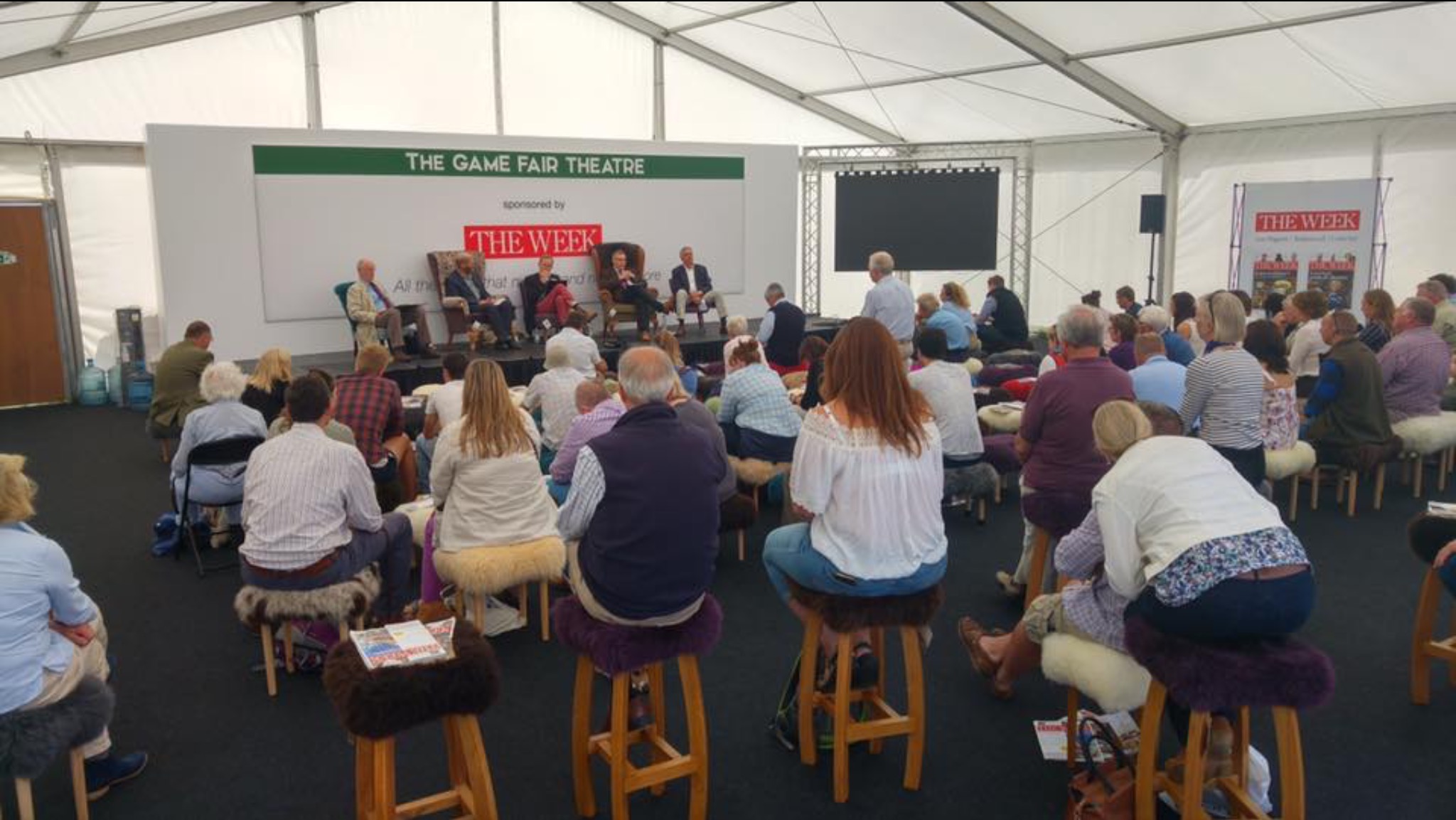 Debating fox hunting and the Hunting Act at The Game Fair 2016. Photo credit: Oli Melzack
Debating fox hunting and the Hunting Act at The Game Fair 2016. Photo credit: Oli Melzack
From the moment we had a social media presence we’ve had trolls. Online abuse is inevitable when you’re standing up to be counted. We don’t support it or partake. Hounds Off fundamentally disapproves of antisocial behaviour from anyone on any side.
We accept our own advice regarding trolls which is to, with a very rare exception, ignore them. That’s why their type always quieten down and, mostly, go away.
SPREADING FOXY LOVE
The news is often appalling. Human beings can inflict the most heinous crimes against their kind and fellow creatures. God knows, often the horror is very hard to understand or absorb. However incensed or outraged, we encourage folks in our Hounds Off community to spread foxy love instead.
To achieve the dream, foxy love must reach beyond its comfort zone and into what might be described as enemy territory. Foxy love seeks also to find common ground with people who, by whatever inclination, are practitioners of or apologists for foxy hate - folks who are not our natural bedfellows. That’s why it was great to represent Hounds Off in a debate about fox hunting and the Hunting Act at The Game Fair in July. There’s no doubt that we challenged negative stereotypes and made a few die-hard hunt supporters think, however briefly, about the cruelty which is central to the pleasure they feel from participating in ‘country sports’.
We advertised our attendance in advance so that all our trolls were informed and aware of their chance to discuss the rights and wrongs of killing for sport face to face and in the comfort of their home turf. For reasons known only to themselves, our trolls didn’t grasp their opportunity, or if they did decided to keep quiet.
NO-PLATFORM ATTEMPT
A year ago Hounds Off was represented at the Winchester Hunting Symposium. There were all sorts of smear campaigns from hunt supporters beforehand. One of our then-regular trolls even published a rubbishing blog full of lies and misinformation designed to scupper the event (it has since been removed). Additionally, as the Hounds Off representative, I was personally besmirched and accused of supporting violent protest. A pro hunt MP threatened to pull out of participating if I was given a voice. I had to answer to the organiser and he then justified my attendance to Winchester University elders who decided the outcome of this no-platform attempt. We took it as complimentary when the Countryside Alliance joined in.
It’s good to have a voice and be listened to. Hounds Off attended the Winchester Hunting Symposium and, on behalf of hunted animals, our voice was heard.
DORSET DING-DONG
Recently we had a little ding-dong in the Dorset press about the seldom-mentioned issue of Hunts killing healthy but unwanted surplus hounds. For whatever reason, the Blackmore Vale Magazine Editor closed correspondence having given a hound-killing apologist the last, and inaccurate, word.
We used our social media platforms to keep this issue alive and it was latched on to by a troll who, evidently spoiling for an online argument, was particularly prolific about a month ago.
Our troll had been sprinkling mischief here and there. We monitored his presence discreetly but, as stated earlier, are not in the habit of censoring comments. After all, it’s good to talk.
Eventually our troll settled down into a dialogue with a Hounds Off supporter and the nitty-gritty realities of trailhunting aka foxhunting.
PSEUDO-SCIENCE
Eventually, playing his believed trump card, our troll posted a link to the Veterinary Association for Wildlife Management (VAWM). The VAWM works towards repeal of the Hunting Act by employing lengthy, convoluted and twisted interpretations of pseudo-science to, incredibly, justify bloodsports. When you hear the likes of Conservative Party Environment Secretary Angela Leadsom say that hunting with hounds is good for animal welfare, this is where she gets her stuff.
Although superficially persuasive, we encourage all who are tempted to look a little deeper and read between the lines. VAWM arguments in support of bloodsports are fatally flawed.
COMMUNICATING & BEING HEARD
It’s good to have a voice, to talk, to be listened to. Via our website and social media platforms, Hounds Off continues spreading news, views and foxy love, giving all-comers a safe place to express themselves and censoring rarely.
In solidarity with people who wish to protect their property, livestock and pets from hunt trespass, we offer ongoing support, help, advice and back-up.
In defence of the Hunting Act 2004, Hounds Off will carry on deconstructing the propaganda and exposing the lies of bloodsports apologists who have yet to accept that the cruel pastimes of hunting wild animals with dogs for sport have been ruled as socially unacceptable.
© Joe Hashman

